Management Accounting: Costing, Budgeting and Performance Analysis
VerifiedAdded on 2024/05/21
|31
|5584
|470
Report
AI Summary
This report provides a comprehensive overview of management accounting principles and tools applicable to business organizations, particularly focusing on how these can be used to address challenges faced by a company named UK tech ltd. It delves into the essential requirements and types of management accounting, distinguishing it from financial accounting. The report explains costing methods like actual, normal, and standard costing, along with inventory management techniques such as Economic Order Quantity (EOQ), LIFO, FIFO, and Just-in-Time (JIT). It also covers job costing and different types of management accounting reports, including cost, inventory, investment, and budget reports. Furthermore, the document explains marginal and absorption costing, budgeting processes, and the importance of budgets for planning and control. Finally, it discusses the balanced scorecard approach for ensuring quality in business operations, highlighting how management accounting can lead organizations to sustainable success by addressing financial problems effectively.
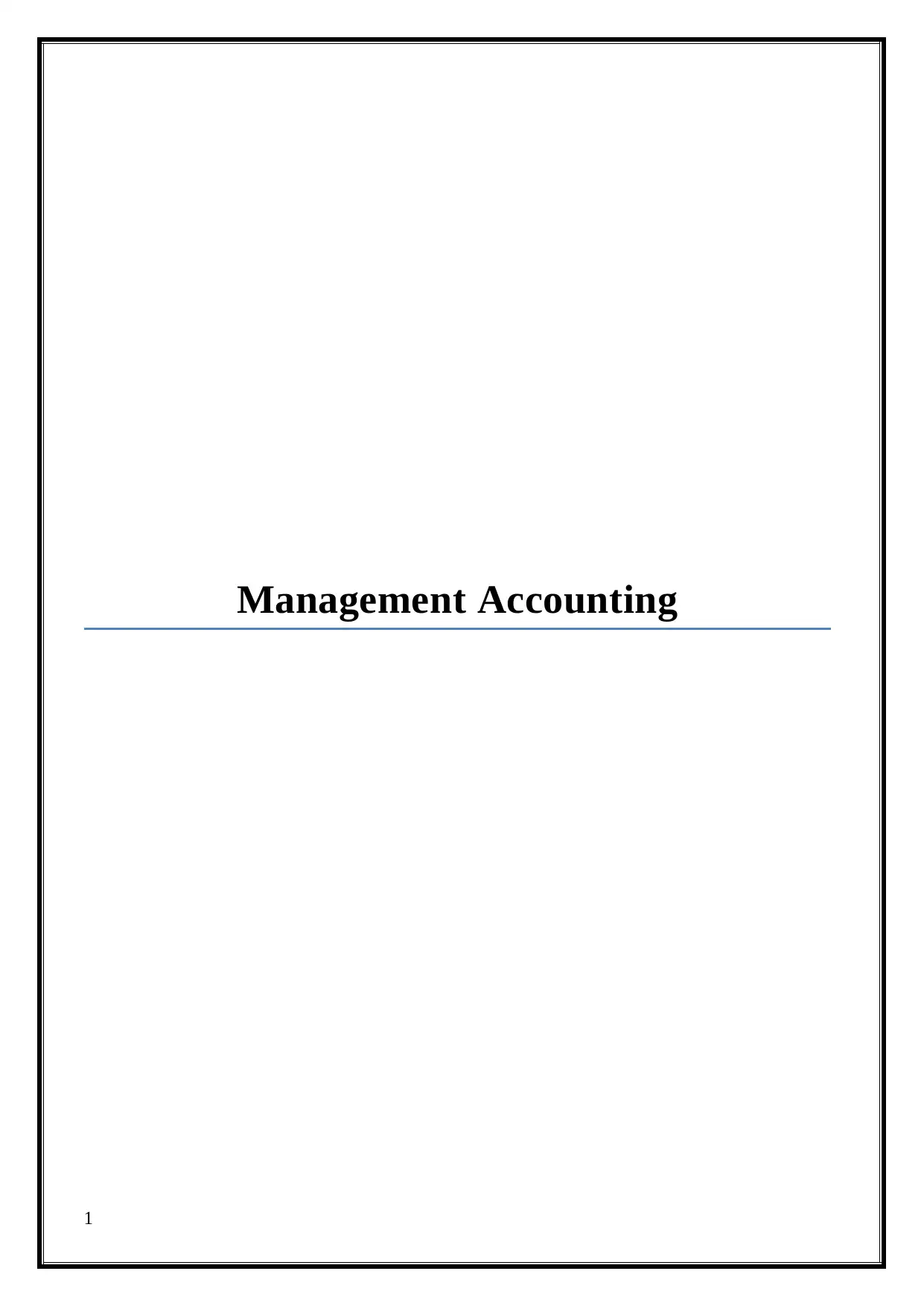
Management Accounting
1
1
Paraphrase This Document
Need a fresh take? Get an instant paraphrase of this document with our AI Paraphraser
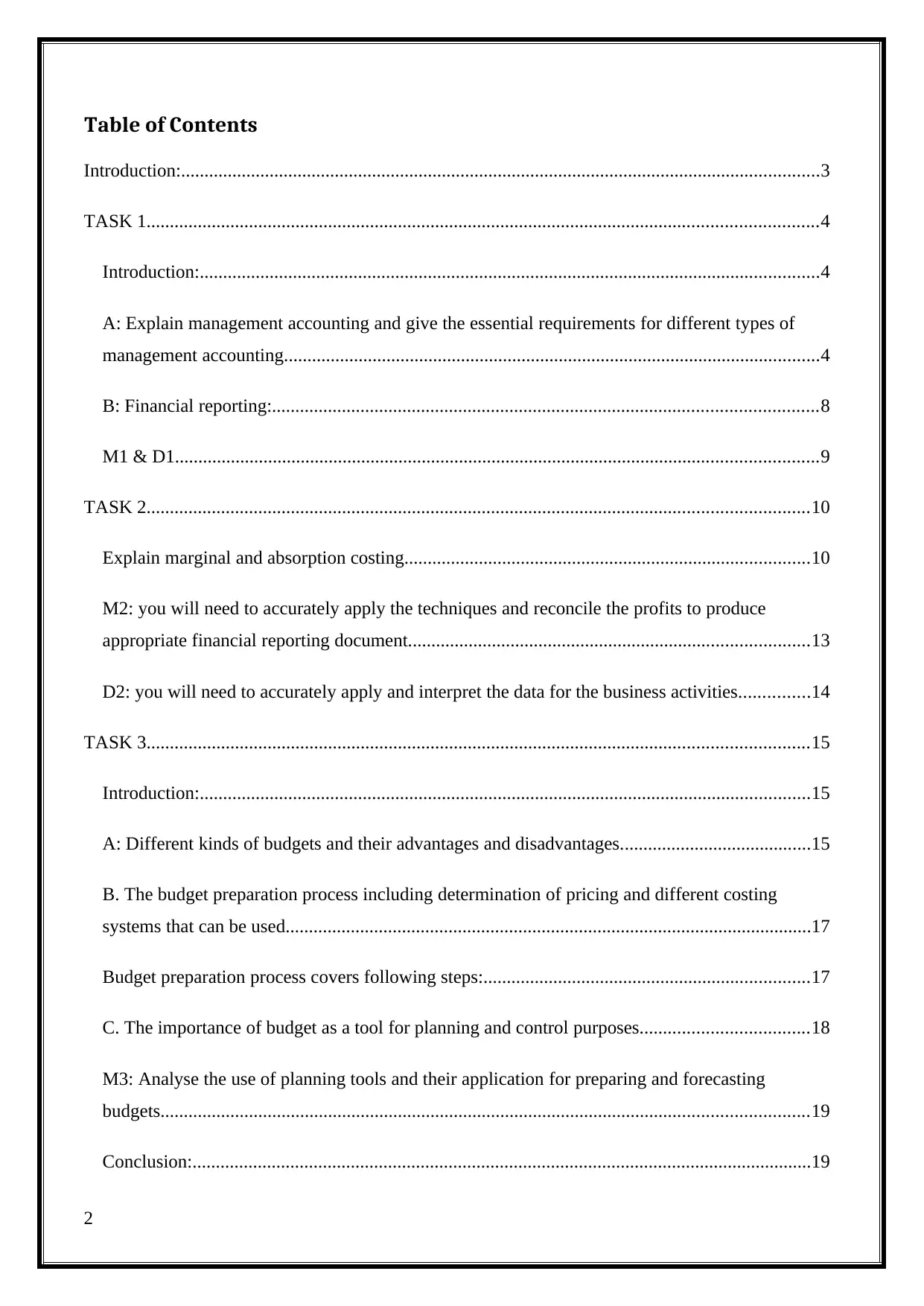
Table of Contents
Introduction:.........................................................................................................................................3
TASK 1................................................................................................................................................4
Introduction:.....................................................................................................................................4
A: Explain management accounting and give the essential requirements for different types of
management accounting...................................................................................................................4
B: Financial reporting:.....................................................................................................................8
M1 & D1..........................................................................................................................................9
TASK 2..............................................................................................................................................10
Explain marginal and absorption costing.......................................................................................10
M2: you will need to accurately apply the techniques and reconcile the profits to produce
appropriate financial reporting document......................................................................................13
D2: you will need to accurately apply and interpret the data for the business activities...............14
TASK 3..............................................................................................................................................15
Introduction:...................................................................................................................................15
A: Different kinds of budgets and their advantages and disadvantages.........................................15
B. The budget preparation process including determination of pricing and different costing
systems that can be used.................................................................................................................17
Budget preparation process covers following steps:......................................................................17
C. The importance of budget as a tool for planning and control purposes....................................18
M3: Analyse the use of planning tools and their application for preparing and forecasting
budgets...........................................................................................................................................19
Conclusion:.....................................................................................................................................19
2
Introduction:.........................................................................................................................................3
TASK 1................................................................................................................................................4
Introduction:.....................................................................................................................................4
A: Explain management accounting and give the essential requirements for different types of
management accounting...................................................................................................................4
B: Financial reporting:.....................................................................................................................8
M1 & D1..........................................................................................................................................9
TASK 2..............................................................................................................................................10
Explain marginal and absorption costing.......................................................................................10
M2: you will need to accurately apply the techniques and reconcile the profits to produce
appropriate financial reporting document......................................................................................13
D2: you will need to accurately apply and interpret the data for the business activities...............14
TASK 3..............................................................................................................................................15
Introduction:...................................................................................................................................15
A: Different kinds of budgets and their advantages and disadvantages.........................................15
B. The budget preparation process including determination of pricing and different costing
systems that can be used.................................................................................................................17
Budget preparation process covers following steps:......................................................................17
C. The importance of budget as a tool for planning and control purposes....................................18
M3: Analyse the use of planning tools and their application for preparing and forecasting
budgets...........................................................................................................................................19
Conclusion:.....................................................................................................................................19
2
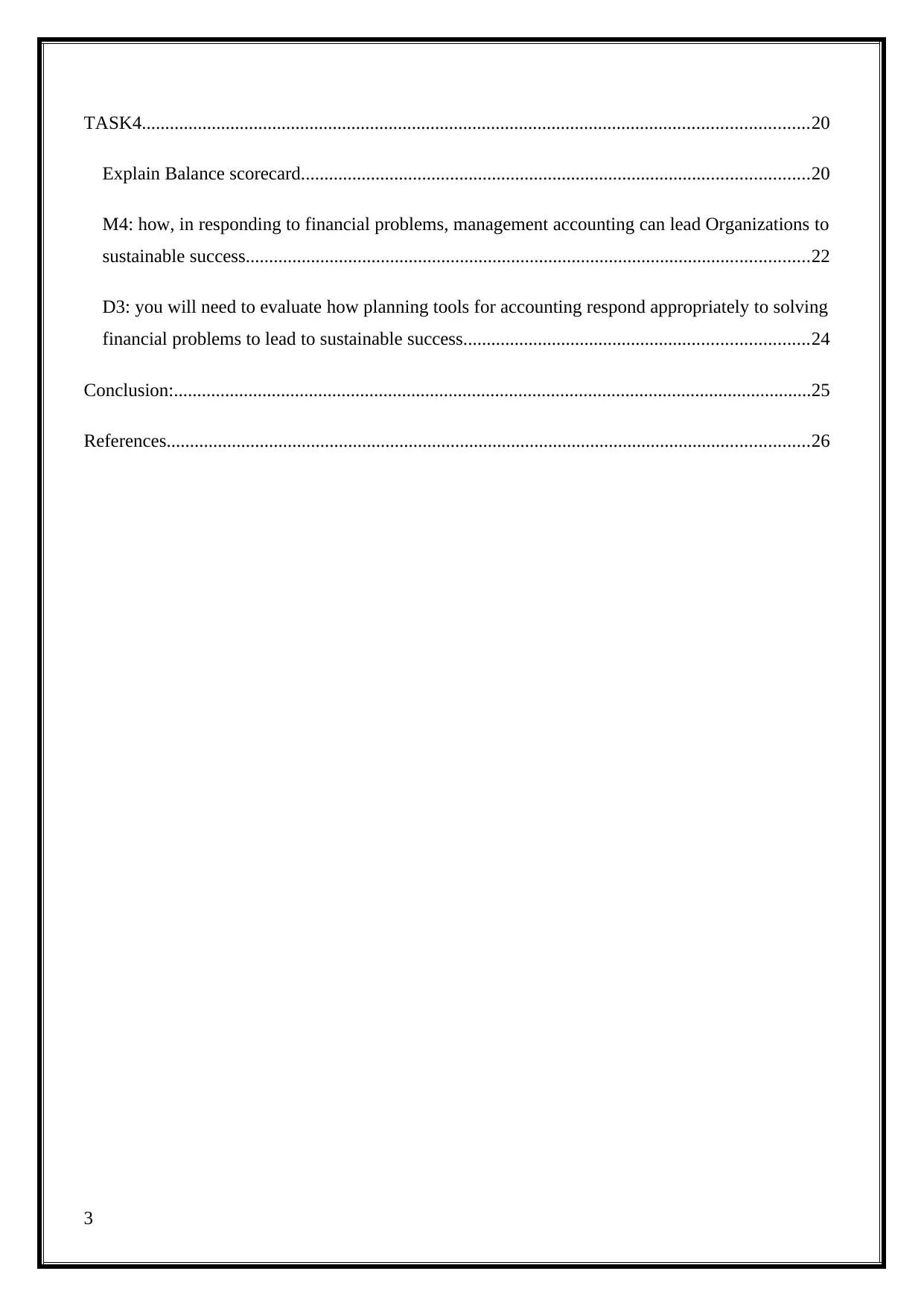
TASK4...............................................................................................................................................20
Explain Balance scorecard.............................................................................................................20
M4: how, in responding to financial problems, management accounting can lead Organizations to
sustainable success.........................................................................................................................22
D3: you will need to evaluate how planning tools for accounting respond appropriately to solving
financial problems to lead to sustainable success..........................................................................24
Conclusion:.........................................................................................................................................25
References..........................................................................................................................................26
3
Explain Balance scorecard.............................................................................................................20
M4: how, in responding to financial problems, management accounting can lead Organizations to
sustainable success.........................................................................................................................22
D3: you will need to evaluate how planning tools for accounting respond appropriately to solving
financial problems to lead to sustainable success..........................................................................24
Conclusion:.........................................................................................................................................25
References..........................................................................................................................................26
3
⊘ This is a preview!⊘
Do you want full access?
Subscribe today to unlock all pages.

Trusted by 1+ million students worldwide
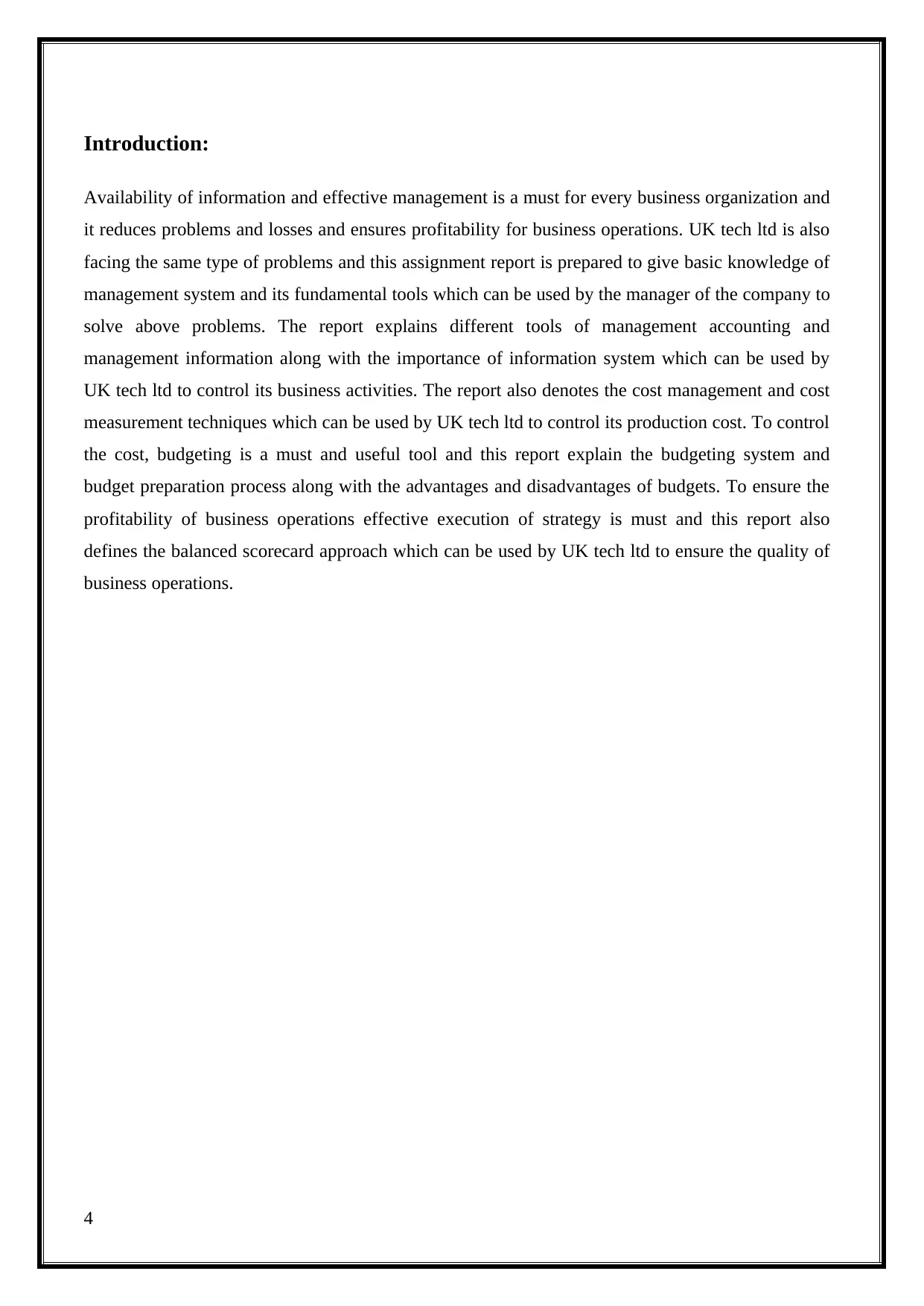
Introduction:
Availability of information and effective management is a must for every business organization and
it reduces problems and losses and ensures profitability for business operations. UK tech ltd is also
facing the same type of problems and this assignment report is prepared to give basic knowledge of
management system and its fundamental tools which can be used by the manager of the company to
solve above problems. The report explains different tools of management accounting and
management information along with the importance of information system which can be used by
UK tech ltd to control its business activities. The report also denotes the cost management and cost
measurement techniques which can be used by UK tech ltd to control its production cost. To control
the cost, budgeting is a must and useful tool and this report explain the budgeting system and
budget preparation process along with the advantages and disadvantages of budgets. To ensure the
profitability of business operations effective execution of strategy is must and this report also
defines the balanced scorecard approach which can be used by UK tech ltd to ensure the quality of
business operations.
4
Availability of information and effective management is a must for every business organization and
it reduces problems and losses and ensures profitability for business operations. UK tech ltd is also
facing the same type of problems and this assignment report is prepared to give basic knowledge of
management system and its fundamental tools which can be used by the manager of the company to
solve above problems. The report explains different tools of management accounting and
management information along with the importance of information system which can be used by
UK tech ltd to control its business activities. The report also denotes the cost management and cost
measurement techniques which can be used by UK tech ltd to control its production cost. To control
the cost, budgeting is a must and useful tool and this report explain the budgeting system and
budget preparation process along with the advantages and disadvantages of budgets. To ensure the
profitability of business operations effective execution of strategy is must and this report also
defines the balanced scorecard approach which can be used by UK tech ltd to ensure the quality of
business operations.
4
Paraphrase This Document
Need a fresh take? Get an instant paraphrase of this document with our AI Paraphraser
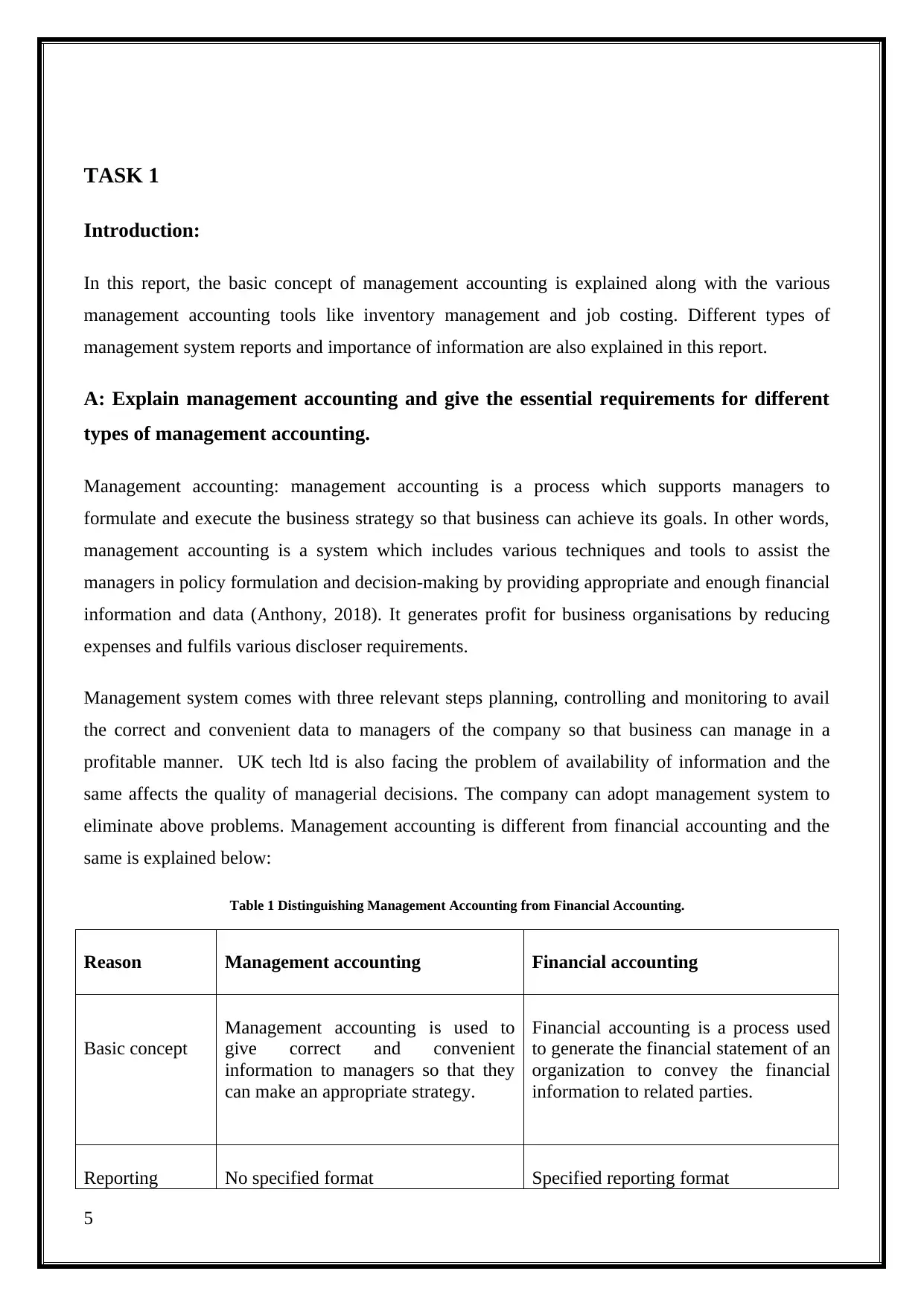
TASK 1
Introduction:
In this report, the basic concept of management accounting is explained along with the various
management accounting tools like inventory management and job costing. Different types of
management system reports and importance of information are also explained in this report.
A: Explain management accounting and give the essential requirements for different
types of management accounting.
Management accounting: management accounting is a process which supports managers to
formulate and execute the business strategy so that business can achieve its goals. In other words,
management accounting is a system which includes various techniques and tools to assist the
managers in policy formulation and decision-making by providing appropriate and enough financial
information and data (Anthony, 2018). It generates profit for business organisations by reducing
expenses and fulfils various discloser requirements.
Management system comes with three relevant steps planning, controlling and monitoring to avail
the correct and convenient data to managers of the company so that business can manage in a
profitable manner. UK tech ltd is also facing the problem of availability of information and the
same affects the quality of managerial decisions. The company can adopt management system to
eliminate above problems. Management accounting is different from financial accounting and the
same is explained below:
Table 1 Distinguishing Management Accounting from Financial Accounting.
Reason Management accounting Financial accounting
Basic concept
Management accounting is used to
give correct and convenient
information to managers so that they
can make an appropriate strategy.
Financial accounting is a process used
to generate the financial statement of an
organization to convey the financial
information to related parties.
Reporting No specified format Specified reporting format
5
Introduction:
In this report, the basic concept of management accounting is explained along with the various
management accounting tools like inventory management and job costing. Different types of
management system reports and importance of information are also explained in this report.
A: Explain management accounting and give the essential requirements for different
types of management accounting.
Management accounting: management accounting is a process which supports managers to
formulate and execute the business strategy so that business can achieve its goals. In other words,
management accounting is a system which includes various techniques and tools to assist the
managers in policy formulation and decision-making by providing appropriate and enough financial
information and data (Anthony, 2018). It generates profit for business organisations by reducing
expenses and fulfils various discloser requirements.
Management system comes with three relevant steps planning, controlling and monitoring to avail
the correct and convenient data to managers of the company so that business can manage in a
profitable manner. UK tech ltd is also facing the problem of availability of information and the
same affects the quality of managerial decisions. The company can adopt management system to
eliminate above problems. Management accounting is different from financial accounting and the
same is explained below:
Table 1 Distinguishing Management Accounting from Financial Accounting.
Reason Management accounting Financial accounting
Basic concept
Management accounting is used to
give correct and convenient
information to managers so that they
can make an appropriate strategy.
Financial accounting is a process used
to generate the financial statement of an
organization to convey the financial
information to related parties.
Reporting No specified format Specified reporting format
5
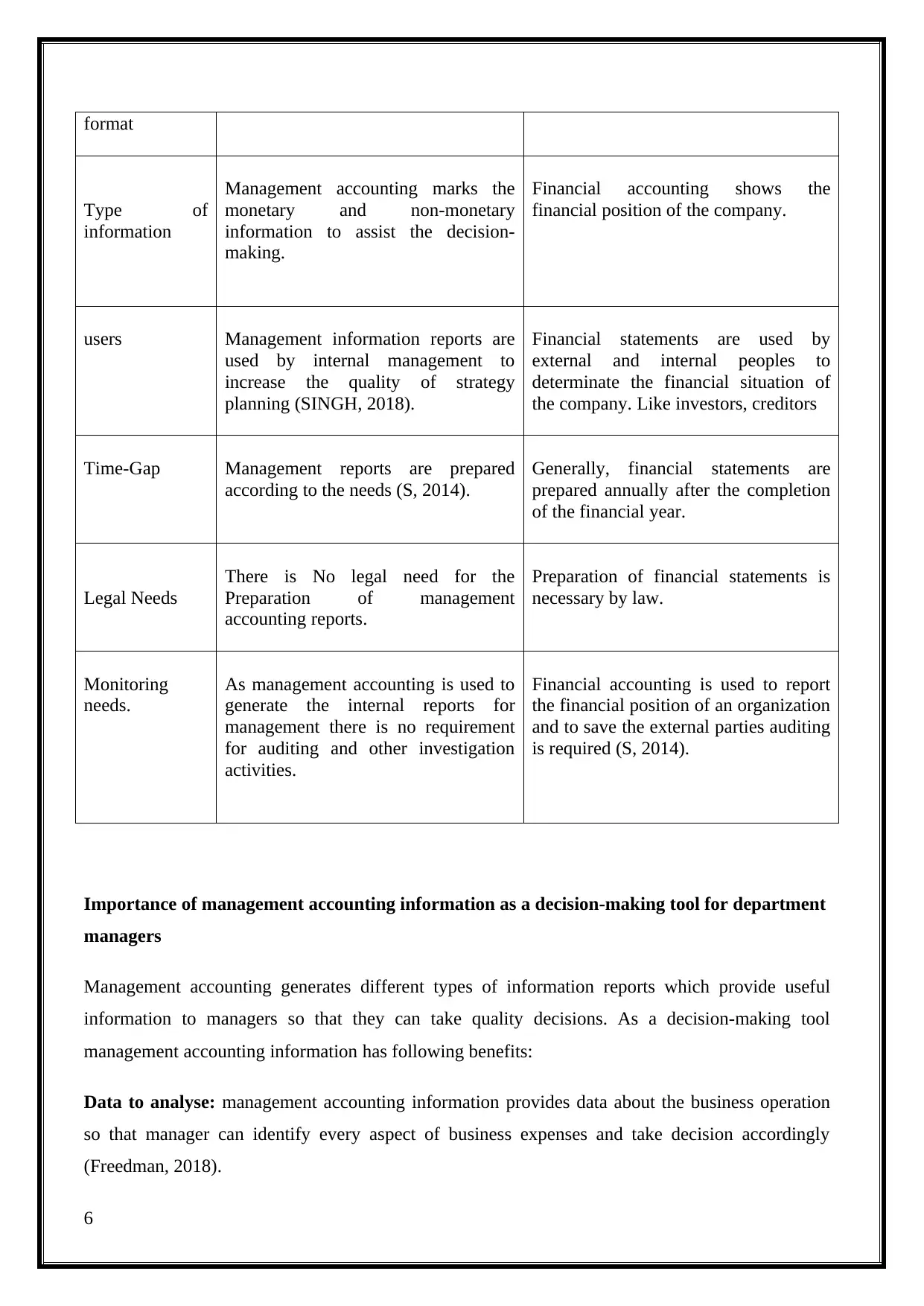
format
Type of
information
Management accounting marks the
monetary and non-monetary
information to assist the decision-
making.
Financial accounting shows the
financial position of the company.
users Management information reports are
used by internal management to
increase the quality of strategy
planning (SINGH, 2018).
Financial statements are used by
external and internal peoples to
determinate the financial situation of
the company. Like investors, creditors
Time-Gap Management reports are prepared
according to the needs (S, 2014).
Generally, financial statements are
prepared annually after the completion
of the financial year.
Legal Needs
There is No legal need for the
Preparation of management
accounting reports.
Preparation of financial statements is
necessary by law.
Monitoring
needs.
As management accounting is used to
generate the internal reports for
management there is no requirement
for auditing and other investigation
activities.
Financial accounting is used to report
the financial position of an organization
and to save the external parties auditing
is required (S, 2014).
Importance of management accounting information as a decision-making tool for department
managers
Management accounting generates different types of information reports which provide useful
information to managers so that they can take quality decisions. As a decision-making tool
management accounting information has following benefits:
Data to analyse: management accounting information provides data about the business operation
so that manager can identify every aspect of business expenses and take decision accordingly
(Freedman, 2018).
6
Type of
information
Management accounting marks the
monetary and non-monetary
information to assist the decision-
making.
Financial accounting shows the
financial position of the company.
users Management information reports are
used by internal management to
increase the quality of strategy
planning (SINGH, 2018).
Financial statements are used by
external and internal peoples to
determinate the financial situation of
the company. Like investors, creditors
Time-Gap Management reports are prepared
according to the needs (S, 2014).
Generally, financial statements are
prepared annually after the completion
of the financial year.
Legal Needs
There is No legal need for the
Preparation of management
accounting reports.
Preparation of financial statements is
necessary by law.
Monitoring
needs.
As management accounting is used to
generate the internal reports for
management there is no requirement
for auditing and other investigation
activities.
Financial accounting is used to report
the financial position of an organization
and to save the external parties auditing
is required (S, 2014).
Importance of management accounting information as a decision-making tool for department
managers
Management accounting generates different types of information reports which provide useful
information to managers so that they can take quality decisions. As a decision-making tool
management accounting information has following benefits:
Data to analyse: management accounting information provides data about the business operation
so that manager can identify every aspect of business expenses and take decision accordingly
(Freedman, 2018).
6
⊘ This is a preview!⊘
Do you want full access?
Subscribe today to unlock all pages.

Trusted by 1+ million students worldwide
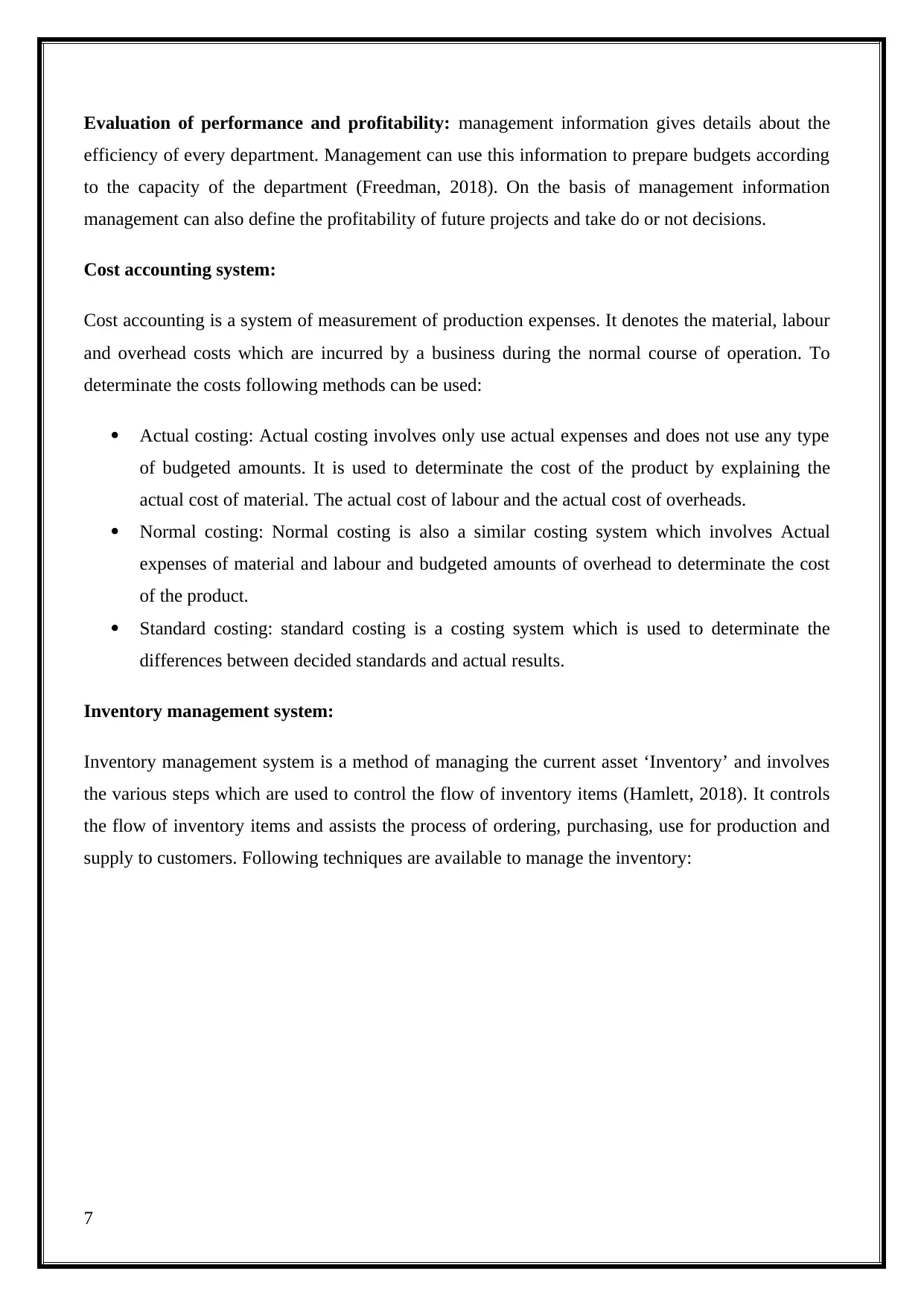
Evaluation of performance and profitability: management information gives details about the
efficiency of every department. Management can use this information to prepare budgets according
to the capacity of the department (Freedman, 2018). On the basis of management information
management can also define the profitability of future projects and take do or not decisions.
Cost accounting system:
Cost accounting is a system of measurement of production expenses. It denotes the material, labour
and overhead costs which are incurred by a business during the normal course of operation. To
determinate the costs following methods can be used:
Actual costing: Actual costing involves only use actual expenses and does not use any type
of budgeted amounts. It is used to determinate the cost of the product by explaining the
actual cost of material. The actual cost of labour and the actual cost of overheads.
Normal costing: Normal costing is also a similar costing system which involves Actual
expenses of material and labour and budgeted amounts of overhead to determinate the cost
of the product.
Standard costing: standard costing is a costing system which is used to determinate the
differences between decided standards and actual results.
Inventory management system:
Inventory management system is a method of managing the current asset ‘Inventory’ and involves
the various steps which are used to control the flow of inventory items (Hamlett, 2018). It controls
the flow of inventory items and assists the process of ordering, purchasing, use for production and
supply to customers. Following techniques are available to manage the inventory:
7
efficiency of every department. Management can use this information to prepare budgets according
to the capacity of the department (Freedman, 2018). On the basis of management information
management can also define the profitability of future projects and take do or not decisions.
Cost accounting system:
Cost accounting is a system of measurement of production expenses. It denotes the material, labour
and overhead costs which are incurred by a business during the normal course of operation. To
determinate the costs following methods can be used:
Actual costing: Actual costing involves only use actual expenses and does not use any type
of budgeted amounts. It is used to determinate the cost of the product by explaining the
actual cost of material. The actual cost of labour and the actual cost of overheads.
Normal costing: Normal costing is also a similar costing system which involves Actual
expenses of material and labour and budgeted amounts of overhead to determinate the cost
of the product.
Standard costing: standard costing is a costing system which is used to determinate the
differences between decided standards and actual results.
Inventory management system:
Inventory management system is a method of managing the current asset ‘Inventory’ and involves
the various steps which are used to control the flow of inventory items (Hamlett, 2018). It controls
the flow of inventory items and assists the process of ordering, purchasing, use for production and
supply to customers. Following techniques are available to manage the inventory:
7
Paraphrase This Document
Need a fresh take? Get an instant paraphrase of this document with our AI Paraphraser
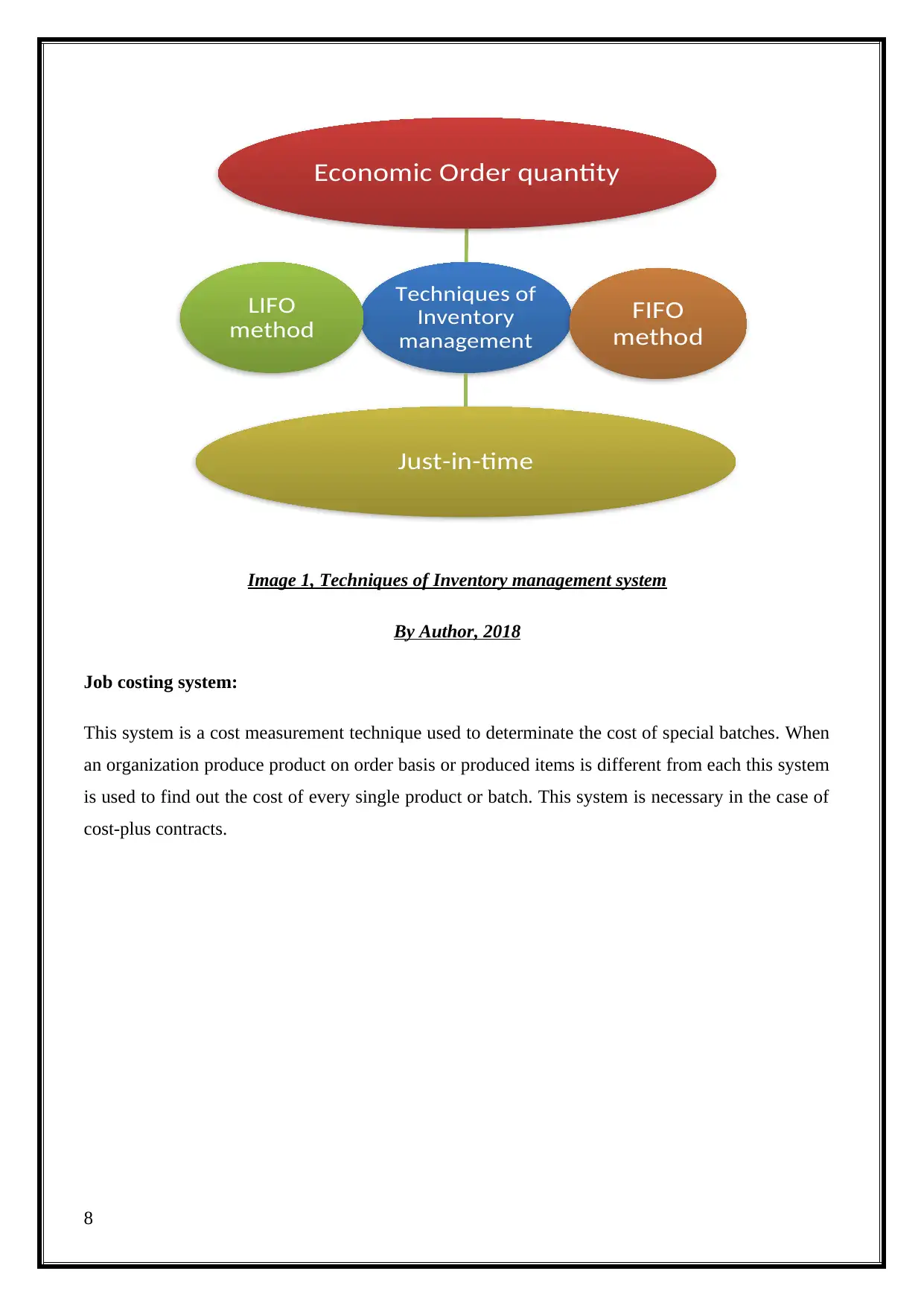
Image 1, Techniques of Inventory management system
By Author, 2018
Job costing system:
This system is a cost measurement technique used to determinate the cost of special batches. When
an organization produce product on order basis or produced items is different from each this system
is used to find out the cost of every single product or batch. This system is necessary in the case of
cost-plus contracts.
8
Techniques of
Inventory
management
Economic Order quantity
FIFO
method
Just-in-time
LIFO
method
By Author, 2018
Job costing system:
This system is a cost measurement technique used to determinate the cost of special batches. When
an organization produce product on order basis or produced items is different from each this system
is used to find out the cost of every single product or batch. This system is necessary in the case of
cost-plus contracts.
8
Techniques of
Inventory
management
Economic Order quantity
FIFO
method
Just-in-time
LIFO
method
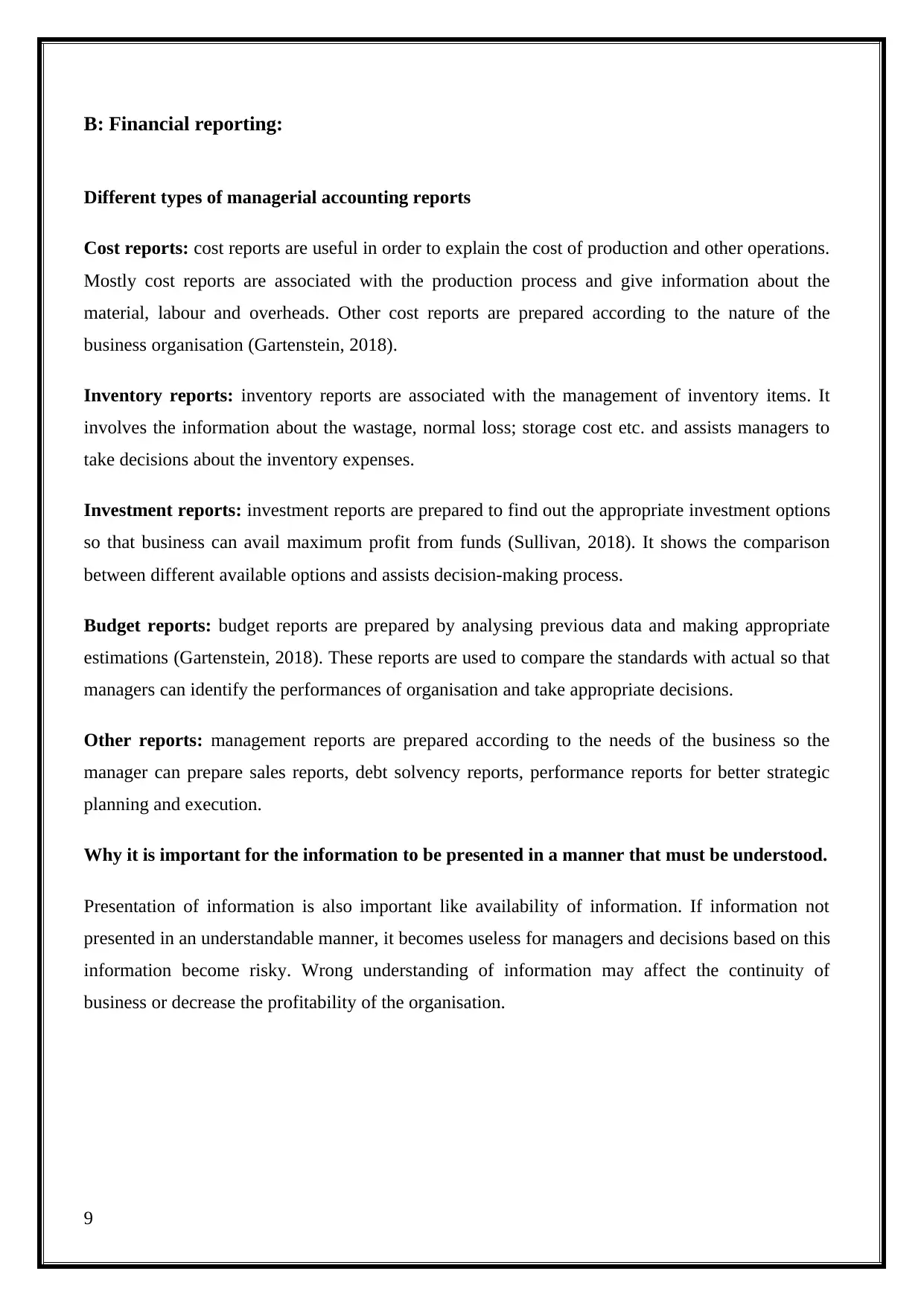
B: Financial reporting:
Different types of managerial accounting reports
Cost reports: cost reports are useful in order to explain the cost of production and other operations.
Mostly cost reports are associated with the production process and give information about the
material, labour and overheads. Other cost reports are prepared according to the nature of the
business organisation (Gartenstein, 2018).
Inventory reports: inventory reports are associated with the management of inventory items. It
involves the information about the wastage, normal loss; storage cost etc. and assists managers to
take decisions about the inventory expenses.
Investment reports: investment reports are prepared to find out the appropriate investment options
so that business can avail maximum profit from funds (Sullivan, 2018). It shows the comparison
between different available options and assists decision-making process.
Budget reports: budget reports are prepared by analysing previous data and making appropriate
estimations (Gartenstein, 2018). These reports are used to compare the standards with actual so that
managers can identify the performances of organisation and take appropriate decisions.
Other reports: management reports are prepared according to the needs of the business so the
manager can prepare sales reports, debt solvency reports, performance reports for better strategic
planning and execution.
Why it is important for the information to be presented in a manner that must be understood.
Presentation of information is also important like availability of information. If information not
presented in an understandable manner, it becomes useless for managers and decisions based on this
information become risky. Wrong understanding of information may affect the continuity of
business or decrease the profitability of the organisation.
9
Different types of managerial accounting reports
Cost reports: cost reports are useful in order to explain the cost of production and other operations.
Mostly cost reports are associated with the production process and give information about the
material, labour and overheads. Other cost reports are prepared according to the nature of the
business organisation (Gartenstein, 2018).
Inventory reports: inventory reports are associated with the management of inventory items. It
involves the information about the wastage, normal loss; storage cost etc. and assists managers to
take decisions about the inventory expenses.
Investment reports: investment reports are prepared to find out the appropriate investment options
so that business can avail maximum profit from funds (Sullivan, 2018). It shows the comparison
between different available options and assists decision-making process.
Budget reports: budget reports are prepared by analysing previous data and making appropriate
estimations (Gartenstein, 2018). These reports are used to compare the standards with actual so that
managers can identify the performances of organisation and take appropriate decisions.
Other reports: management reports are prepared according to the needs of the business so the
manager can prepare sales reports, debt solvency reports, performance reports for better strategic
planning and execution.
Why it is important for the information to be presented in a manner that must be understood.
Presentation of information is also important like availability of information. If information not
presented in an understandable manner, it becomes useless for managers and decisions based on this
information become risky. Wrong understanding of information may affect the continuity of
business or decrease the profitability of the organisation.
9
⊘ This is a preview!⊘
Do you want full access?
Subscribe today to unlock all pages.

Trusted by 1+ million students worldwide
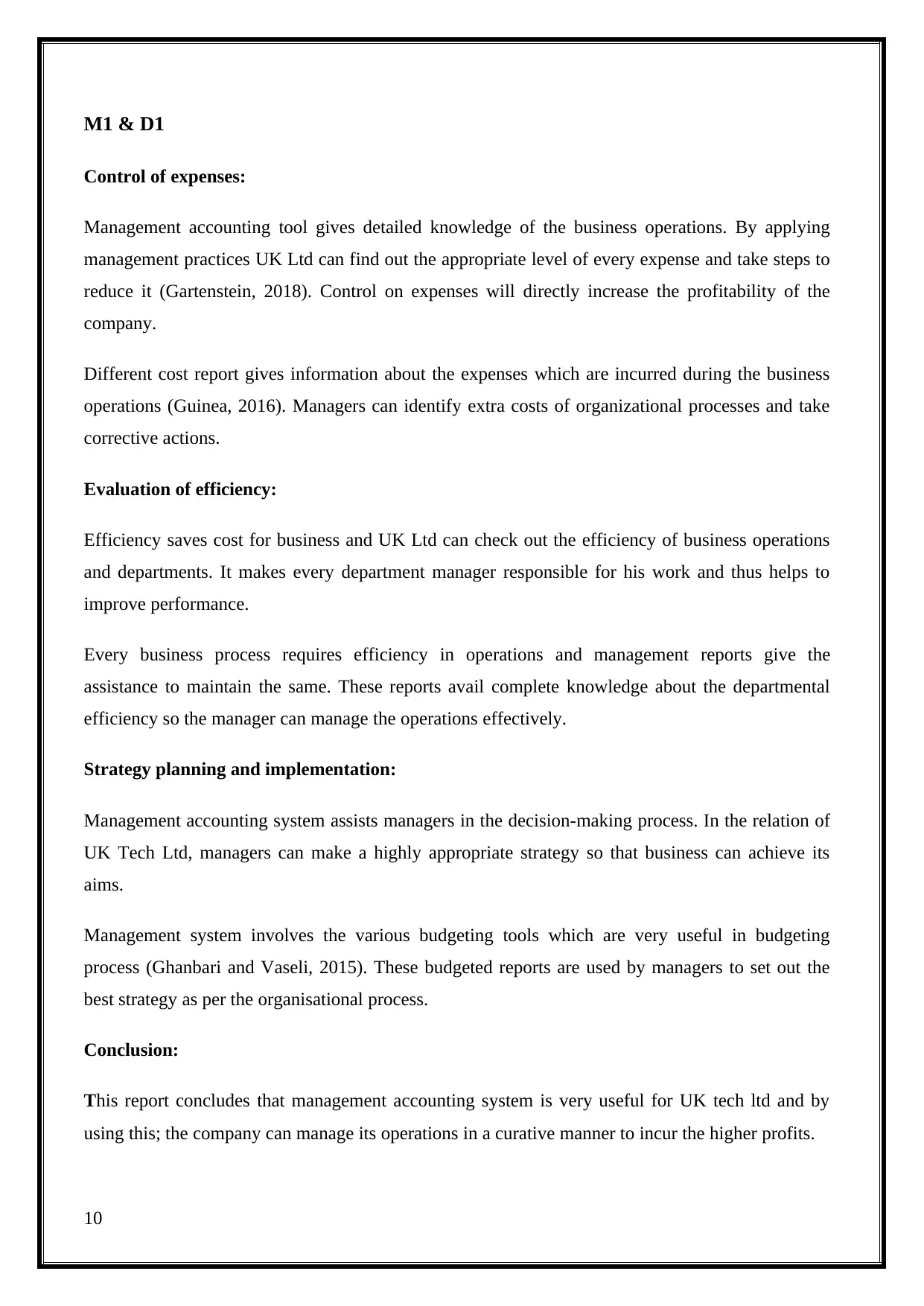
M1 & D1
Control of expenses:
Management accounting tool gives detailed knowledge of the business operations. By applying
management practices UK Ltd can find out the appropriate level of every expense and take steps to
reduce it (Gartenstein, 2018). Control on expenses will directly increase the profitability of the
company.
Different cost report gives information about the expenses which are incurred during the business
operations (Guinea, 2016). Managers can identify extra costs of organizational processes and take
corrective actions.
Evaluation of efficiency:
Efficiency saves cost for business and UK Ltd can check out the efficiency of business operations
and departments. It makes every department manager responsible for his work and thus helps to
improve performance.
Every business process requires efficiency in operations and management reports give the
assistance to maintain the same. These reports avail complete knowledge about the departmental
efficiency so the manager can manage the operations effectively.
Strategy planning and implementation:
Management accounting system assists managers in the decision-making process. In the relation of
UK Tech Ltd, managers can make a highly appropriate strategy so that business can achieve its
aims.
Management system involves the various budgeting tools which are very useful in budgeting
process (Ghanbari and Vaseli, 2015). These budgeted reports are used by managers to set out the
best strategy as per the organisational process.
Conclusion:
This report concludes that management accounting system is very useful for UK tech ltd and by
using this; the company can manage its operations in a curative manner to incur the higher profits.
10
Control of expenses:
Management accounting tool gives detailed knowledge of the business operations. By applying
management practices UK Ltd can find out the appropriate level of every expense and take steps to
reduce it (Gartenstein, 2018). Control on expenses will directly increase the profitability of the
company.
Different cost report gives information about the expenses which are incurred during the business
operations (Guinea, 2016). Managers can identify extra costs of organizational processes and take
corrective actions.
Evaluation of efficiency:
Efficiency saves cost for business and UK Ltd can check out the efficiency of business operations
and departments. It makes every department manager responsible for his work and thus helps to
improve performance.
Every business process requires efficiency in operations and management reports give the
assistance to maintain the same. These reports avail complete knowledge about the departmental
efficiency so the manager can manage the operations effectively.
Strategy planning and implementation:
Management accounting system assists managers in the decision-making process. In the relation of
UK Tech Ltd, managers can make a highly appropriate strategy so that business can achieve its
aims.
Management system involves the various budgeting tools which are very useful in budgeting
process (Ghanbari and Vaseli, 2015). These budgeted reports are used by managers to set out the
best strategy as per the organisational process.
Conclusion:
This report concludes that management accounting system is very useful for UK tech ltd and by
using this; the company can manage its operations in a curative manner to incur the higher profits.
10
Paraphrase This Document
Need a fresh take? Get an instant paraphrase of this document with our AI Paraphraser
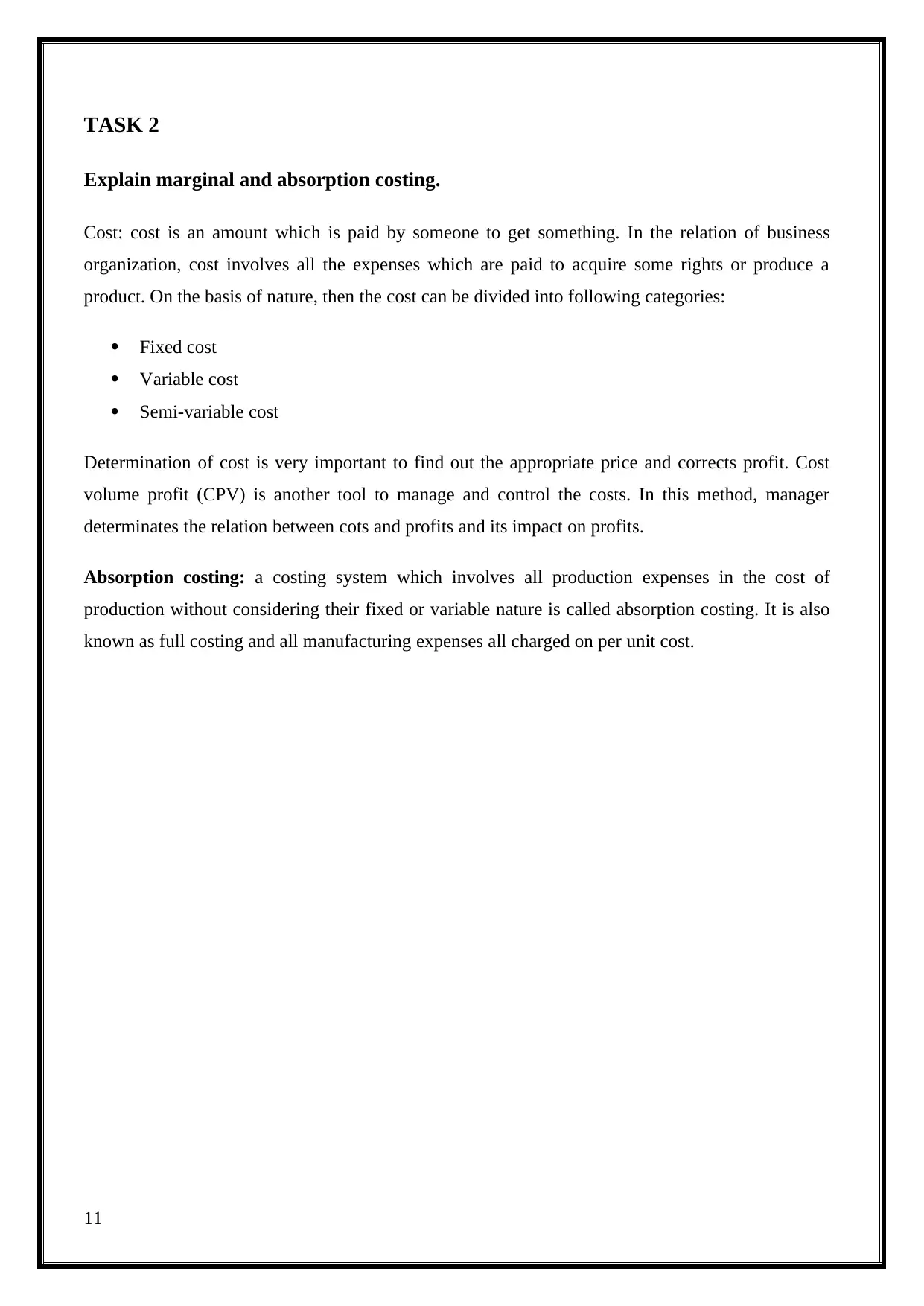
TASK 2
Explain marginal and absorption costing.
Cost: cost is an amount which is paid by someone to get something. In the relation of business
organization, cost involves all the expenses which are paid to acquire some rights or produce a
product. On the basis of nature, then the cost can be divided into following categories:
Fixed cost
Variable cost
Semi-variable cost
Determination of cost is very important to find out the appropriate price and corrects profit. Cost
volume profit (CPV) is another tool to manage and control the costs. In this method, manager
determinates the relation between cots and profits and its impact on profits.
Absorption costing: a costing system which involves all production expenses in the cost of
production without considering their fixed or variable nature is called absorption costing. It is also
known as full costing and all manufacturing expenses all charged on per unit cost.
11
Explain marginal and absorption costing.
Cost: cost is an amount which is paid by someone to get something. In the relation of business
organization, cost involves all the expenses which are paid to acquire some rights or produce a
product. On the basis of nature, then the cost can be divided into following categories:
Fixed cost
Variable cost
Semi-variable cost
Determination of cost is very important to find out the appropriate price and corrects profit. Cost
volume profit (CPV) is another tool to manage and control the costs. In this method, manager
determinates the relation between cots and profits and its impact on profits.
Absorption costing: a costing system which involves all production expenses in the cost of
production without considering their fixed or variable nature is called absorption costing. It is also
known as full costing and all manufacturing expenses all charged on per unit cost.
11
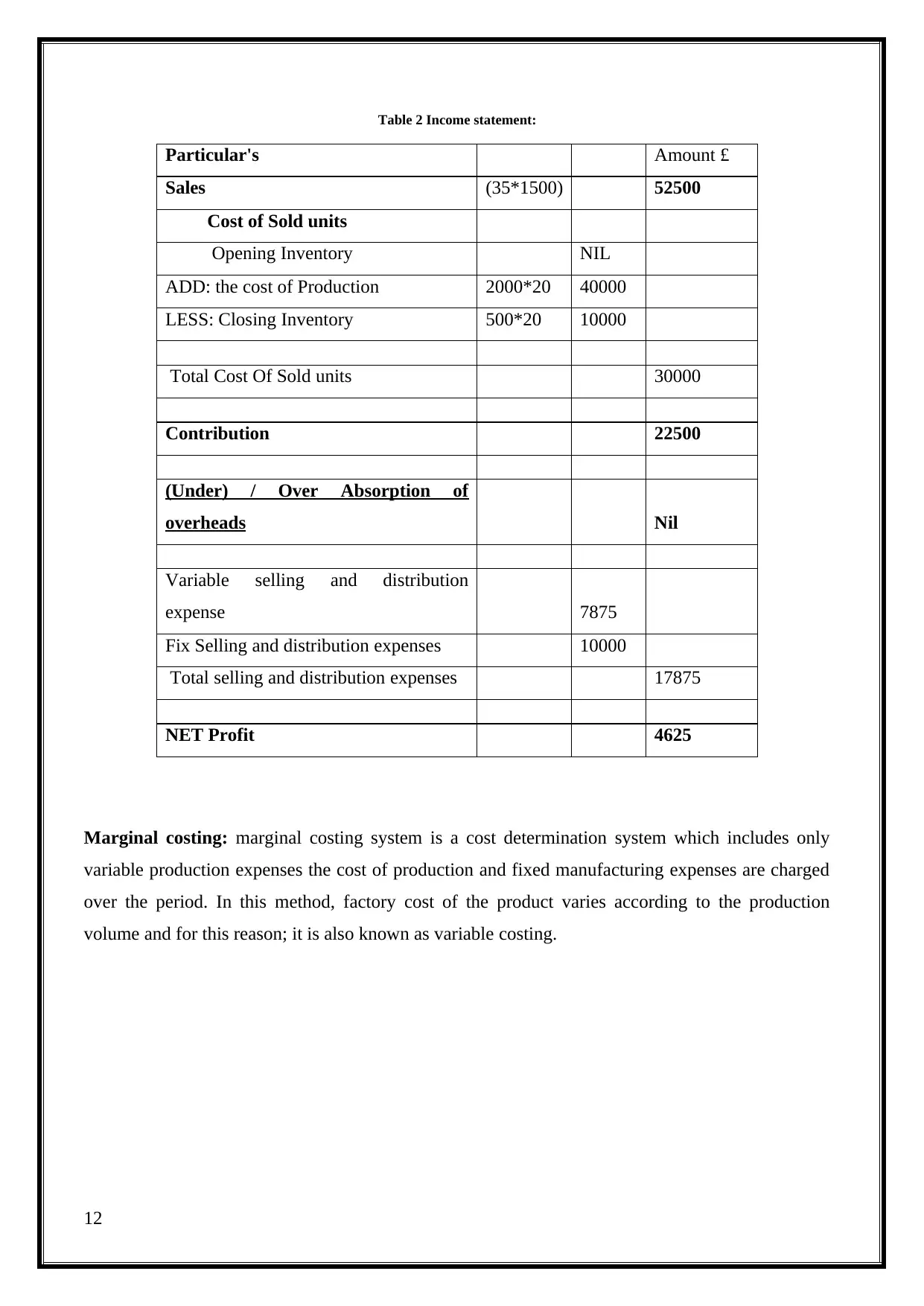
Table 2 Income statement:
Particular's Amount £
Sales (35*1500) 52500
Cost of Sold units
Opening Inventory NIL
ADD: the cost of Production 2000*20 40000
LESS: Closing Inventory 500*20 10000
Total Cost Of Sold units 30000
Contribution 22500
(Under) / Over Absorption of
overheads Nil
Variable selling and distribution
expense 7875
Fix Selling and distribution expenses 10000
Total selling and distribution expenses 17875
NET Profit 4625
Marginal costing: marginal costing system is a cost determination system which includes only
variable production expenses the cost of production and fixed manufacturing expenses are charged
over the period. In this method, factory cost of the product varies according to the production
volume and for this reason; it is also known as variable costing.
12
Particular's Amount £
Sales (35*1500) 52500
Cost of Sold units
Opening Inventory NIL
ADD: the cost of Production 2000*20 40000
LESS: Closing Inventory 500*20 10000
Total Cost Of Sold units 30000
Contribution 22500
(Under) / Over Absorption of
overheads Nil
Variable selling and distribution
expense 7875
Fix Selling and distribution expenses 10000
Total selling and distribution expenses 17875
NET Profit 4625
Marginal costing: marginal costing system is a cost determination system which includes only
variable production expenses the cost of production and fixed manufacturing expenses are charged
over the period. In this method, factory cost of the product varies according to the production
volume and for this reason; it is also known as variable costing.
12
⊘ This is a preview!⊘
Do you want full access?
Subscribe today to unlock all pages.

Trusted by 1+ million students worldwide
1 out of 31
Related Documents
Your All-in-One AI-Powered Toolkit for Academic Success.
+13062052269
info@desklib.com
Available 24*7 on WhatsApp / Email
![[object Object]](/_next/static/media/star-bottom.7253800d.svg)
Unlock your academic potential
Copyright © 2020–2025 A2Z Services. All Rights Reserved. Developed and managed by ZUCOL.





